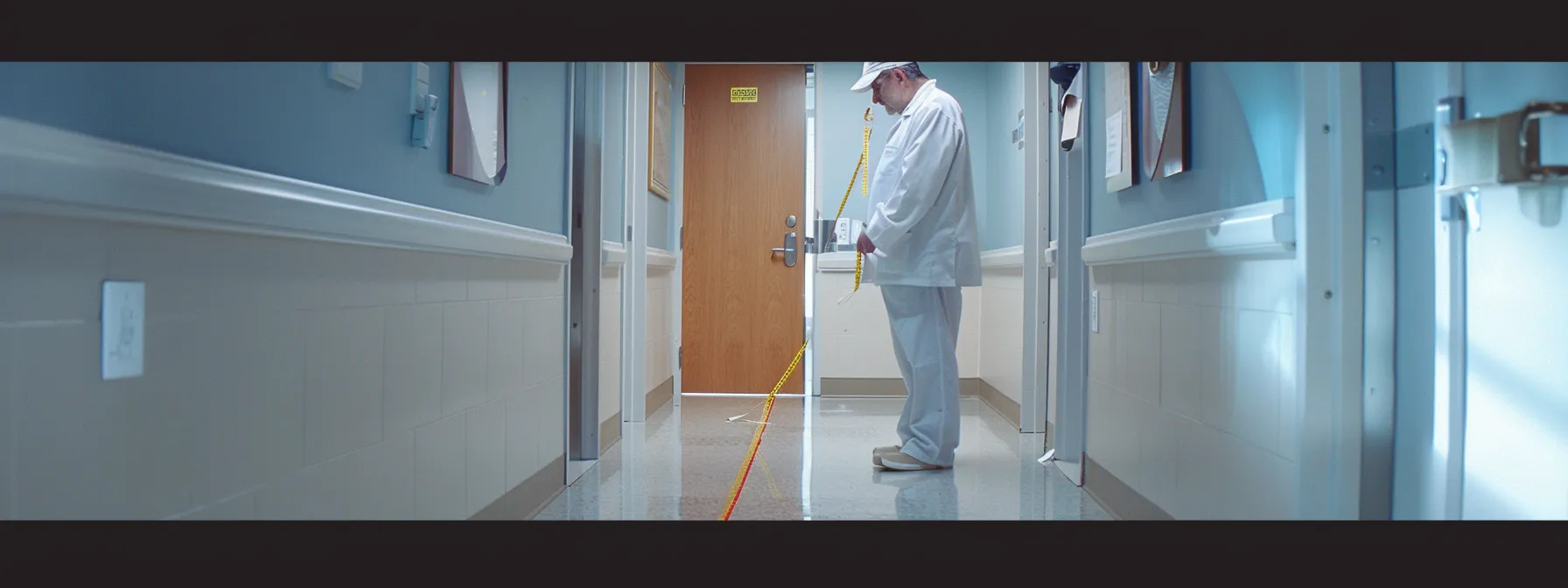
Navigating ADA door clearance standards is essential for architects and designers who strive to create accessible spaces. Proper ADA door clearance not only accommodates wheelchair users but also addresses specific requirements for various structures, from residential bathrooms with bathtubs to safety features like fire doors. Ensuring compliance with these standards is crucial for fostering inclusivity and safety in public and private buildings. To fully grasp the intricacies of ADA door clearance, one must examine the minimum requirements and common challenges encountered in the field. Keep reading to uncover the guidelines that ensure your doors meet ADA clearance standards effectively.

Understanding the minimum door clearance requirements set forth by the ADA is essential for ensuring accessibility in various environments, including health care facilities and public restrooms. Accurate measurement of the clear width for different types of doors, such as those equipped with turnstiles or adjacent to plumbing fixtures, plays a critical role in compliance. Clear width not only facilitates movement but also impacts the overall user experience for individuals with disabilities. Recognizing common mistakes that can lead to non-compliant clearances is vital, as well as learning how to rectify these issues. By addressing these aspects, facilities can create an inclusive environment for all patrons.
Measuring the clear width for different doors involves careful attention to details that affect both transport and usability. A standard doorway must be wide enough to accommodate not just typical passage but also considerations for individuals needing assistance, thus preventing a restrictive tunnel effect that limits movement. This includes ensuring that openings do not encroach into areas like sidewalks and that doorframes are designed to allow enough space for users’ fingers, enabling smooth operation without obstruction.
Clear width is vital for accessibility as it ensures individuals with mobility challenges can comfortably navigate various environments, including those that feature stairs or gates. Sufficient clearance around doorways and entry points allows for easier movement across different floor types, minimizing barriers commonly found in settings such as prisons or newly constructed facilities. By prioritizing clear width, architects and builders can significantly enhance the usability of spaces while promoting inclusivity for all users.
Facilities often overlook the impact of door closers on accessibility. A door closer that applies excessive pressure can create challenges for those navigating through a doorway, particularly in areas such as holding cells where access may be time-sensitive. Additionally, compliance with the International Building Code is essential to avoid complications that arise from improper force settings on door closers, which can lead to a frustrating experience for users requiring assistance.
To correct non-compliant clearances, facility managers should first assess the length of the door opening to ensure it meets ADA specifications. Installing a lever-style handle can simplify door operation, making it more accessible for individuals with limited mobility. Additionally, ensuring that any obstructions, such as a urinal near an entry point or components of a fire alarm system, are positioned appropriately will enhance access, contributing to a functional environment like that of a bus stop.
Having grasped the importance of minimum door clearance under the ADA, readers can now dive into the specific guidelines that govern these requirements. These standards not only ensure accessibility but also enhance the overall experience for all users.

The section outlines fundamental principles associated with ada door clearance, emphasizing the need for adequate dimensions to accommodate individuals utilizing mobility aids. Understanding the specific requirements for various door types is essential, particularly in environments that include facilities such as bathrooms with showers or sinks. This guide addresses necessary adjustments to existing doors, ensuring they remain ADA compliant while providing safe and efficient access for all users. By focusing on these critical elements, facilities can foster an inclusive atmosphere that supports diverse needs and enhances usability.
The basics of ADA door clearance focus on ensuring that doorways are accessible for individuals with disabilities. This involves considering factors such as hinge placement and the proximity of closets, which can affect the necessary clear opening space required for safe and efficient access. Adhering to these guidelines is vital for achieving ADA compliance, as it enhances the usability of spaces and accommodates diverse needs.
The detailed requirements for various types of doors, including those that function as cabinetry, must account for specific dimensions that ensure accessibility. For instance, the clear opening height is particularly crucial when designing doors that allow for easy navigation for individuals using mobility aids or wheelchairs, including those that may need to traverse beneath knee-level installations. Ensuring that the leaf, or gate, is appropriately designed with the necessary height and clearance mitigates obstacles, facilitating seamless access for all users.
Adjusting existing doors to meet ADA standards is essential for ensuring that all individuals, including those in nursing homes who may have disabilities, can move about safely. This involves examining door dimensions, handles, and accessibility features like ramps or elevators to eliminate potential injury risks that could arise from inadequate clearance. Additionally, proximity to facilities such as drinking fountains should be considered, as these elements must not obstruct movement.
| Adjustment Feature | Consideration | Impact on Accessibility |
|---|---|---|
| Door Width | Minimum 32 inches | Accommodates wheelchairs and mobility aids |
| Door Handles | Lever-style or push type | Facilitates use for individuals with limited grip |
| Clear Space Around Doors | Avoidance of obstructions | Reduces risk of injury during navigation |
| Signage Near Elevators | Visible and tactile indicators | Supports individuals with visual impairments |
Understanding the guidelines for ADA door clearance is just the first step. Accurate measurements of clear width will ensure full compliance and accessibility for all.

Accurate measurement of clear widths is vital for meeting ADA standards, particularly in environments like healthcare facilities and public spaces. To achieve compliance, professionals must utilize appropriate tools and methods for precise measurements, ensuring that door openings, including sliding doors, accommodate wheelchair access and movement through aisles. Special considerations should also be given to historic preservation projects, where maintaining architectural integrity must align with current regulations. Ensuring that every measurement adheres to legal requirements prevents barriers to accessibility and promotes an inclusive experience for all individuals.
Accurate measurements for ADA compliance rely on various tools and methods that facilitate precision in assessing clear widths. Professionals often utilize computer hardware to record measurements effectively, ensuring that door widths, latch placements, and grab bar positioning align with building code requirements. Employing digital measuring devices enhances efficiency and accuracy, particularly when assessing the necessities for hand clearance and functionality within accessible environments.
Accuracy in measurements is essential for maintaining compliance with legal standards related to ADA door clearances. In a dwelling, ensuring that doorways are accessible for patients involves accounting for perpendicular approaches and the transition from curb to entryway. This commitment to precise measurement not only meets the law but also enhances the safety and ease of access for all individuals in the facility.
Successful measurement of clear width sets the stage for ensuring accessibility. Next, alterations made to any space can significantly influence door clearance, affecting both functionality and compliance.

Alterations to doorways play a significant role in promoting accessibility within various environments. When considering modifications, it is essential to evaluate the current design and determine when changes are necessary to accommodate users adequately. The integration of telecommunications equipment, for example, may necessitate adjustments to ensure compliance with American National Standards Institute guidelines. Facilities must also assess how these alterations impact employment opportunities for individuals with disabilities, ensuring that access points such as piers or entryways remain unobstructed and user-friendly. By prioritizing thoughtful renovations, facilities can uphold ADA standards and create a more inclusive atmosphere.
Altering doors to enhance accessibility requires a careful examination of existing structures, including the door handle height and spacing in relation to the wall. Facility managers must ensure that any modifications, such as the installation of a revolving door, maintain compliance with ADA standards, providing at least 32 inches of clearance to facilitate movement. By assessing the proximity of additional elements, such as parking space and adjacent walls, planners can optimize access for all users.
Facilities must prioritize adherence to ADA standards during any alterations to doorways, particularly in areas designed for bathing or personal care. Each modification should include thorough documentation that outlines compliance measures and the necessary dimensions to ensure that all individuals, including those with mobility challenges, can access these spaces comfortably. By systematically integrating these practices, facilities maintain an inclusive environment that supports the diverse needs of users.
Alterations can often lead to unexpected challenges, especially when it comes to ensuring proper door clearance. As the conversation shifts, it’s essential to confront the common ADA door clearance challenges that many face.

Addressing the challenges related to ADA door clearance often involves innovative solutions, particularly in tight spaces where conventional adjustments may fall short. Facilities faced with restrictive dimensions may benefit from retrofitting existing doorways to maximize accessibility while complying with regulations. Additionally, examining case studies that showcase successful navigation of clearance issues can provide valuable insights and strategies. These real-world examples illustrate how adaptive measures can transform problem areas into compliant, user-friendly spaces, ultimately enhancing accessibility for all individuals.
Facilities facing tight spatial constraints can implement creative solutions to enhance door clearance compliance. Retrofitting existing doorways with pocket doors or bi-fold systems helps minimize obstruction while ensuring accessibility. Utilizing assistive technology, such as automatic door openers, further improves entry ease without requiring extensive renovations.
| Solution Type | Description | Benefits |
|---|---|---|
| Pocket Doors | Doors that slide into the wall | Maximize usable space while providing full clearance |
| Bi-Fold Doors | Doors that fold in on themselves | Reduce space required for swinging doors |
| Automatic Door Openers | Mechanisms that open doors with a button or sensor | Enhance accessibility without physical effort |
Case studies reveal effective strategies for overcoming ADA door clearance challenges within various environments. One notable example involved a retrofitting project in a historic building where tight doorways posed issues for wheelchair access. The team implemented pocket doors and automatic openers, resulting in both compliance and enhanced user experience.
Identifying the challenges is just the beginning. With the right insights, anyone can ensure their doors comply with ADA clearance standards.

Regular inspections and maintenance of door clearances are imperative for ongoing compliance with ADA standards. Facilities must establish a systematic approach to checking door widths, hinges, and handles to prevent potential accessibility issues from arising. Engaging qualified professionals for ADA compliance reviews ensures that all necessary criteria are met, providing an expert perspective on any necessary adjustments. By fostering a proactive maintenance culture and utilizing expert resources, organizations can uphold accessibility standards and prioritize the needs of all users effectively.
Regular checks and maintenance are integral for maintaining ADA door clearance compliance. Facilities should implement a schedule for evaluating doorways to ensure they meet specified widths and operate smoothly. Addressing any identified issues promptly contributes to a welcoming and accessible environment for all users.
| Maintenance Activity | Frequency | Purpose |
|---|---|---|
| Measure Door Width | Every six months | Ensure compliance with ADA specifications |
| Inspect Door Operation | Quarterly | Identify potential obstruction issues |
| Check Handle Functionality | Monthly | Maintain ease of access for users |
| Evaluate Surrounding Areas | Bi-annually | Ensure clear access zones are maintained |
For facilities seeking thorough ADA compliance reviews, contacting certified accessibility consultants proves beneficial. These professionals possess in-depth knowledge of ADA requirements and can conduct comprehensive assessments tailored to the unique needs of different environments. Engaging with local building codes officials may also provide valuable insights, ensuring that all modifications align with both legal standards and best practices in accessibility.
Navigating ADA door clearance standards plays a vital role in promoting accessibility for individuals with disabilities. Ensuring compliance improves the usability of spaces and fosters an inclusive environment in various settings, such as healthcare facilities and public spaces. Regular assessments and thoughtful alterations to doorways significantly enhance user experience while adhering to legal requirements. By prioritizing these standards, facilities can better accommodate diverse needs and create welcoming spaces for all.

As a business owner, you have a responsibility to ensure that your business complies with the Americans with Disabilities Act(ADA). Not only is it a

When making renovations, there are many things you need to consider, from the structure to the aesthetics of the building. However, one major aspect that